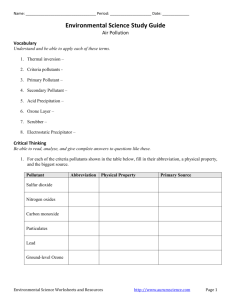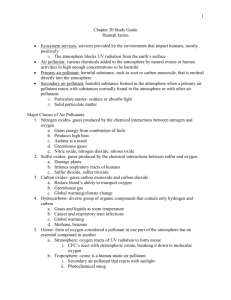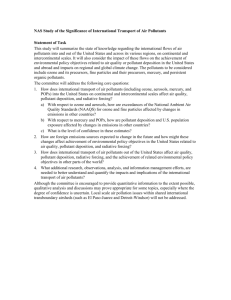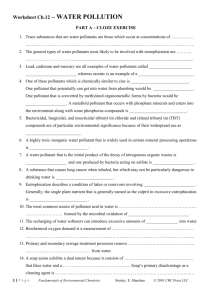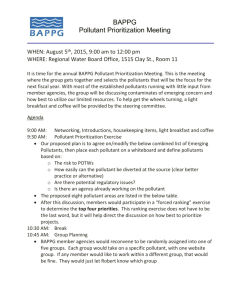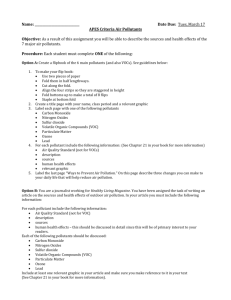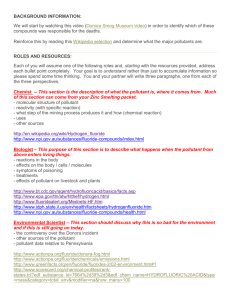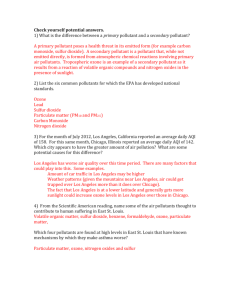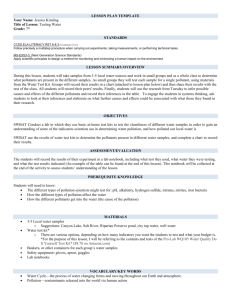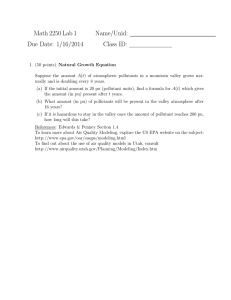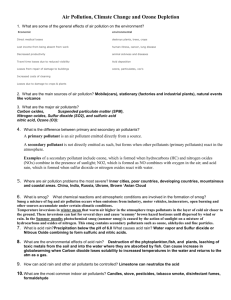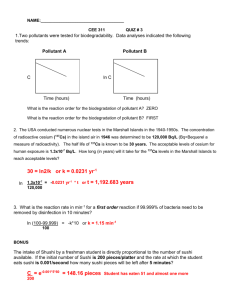Pollution - virtualpharmtox.pharmacy.arizona.edu
advertisement
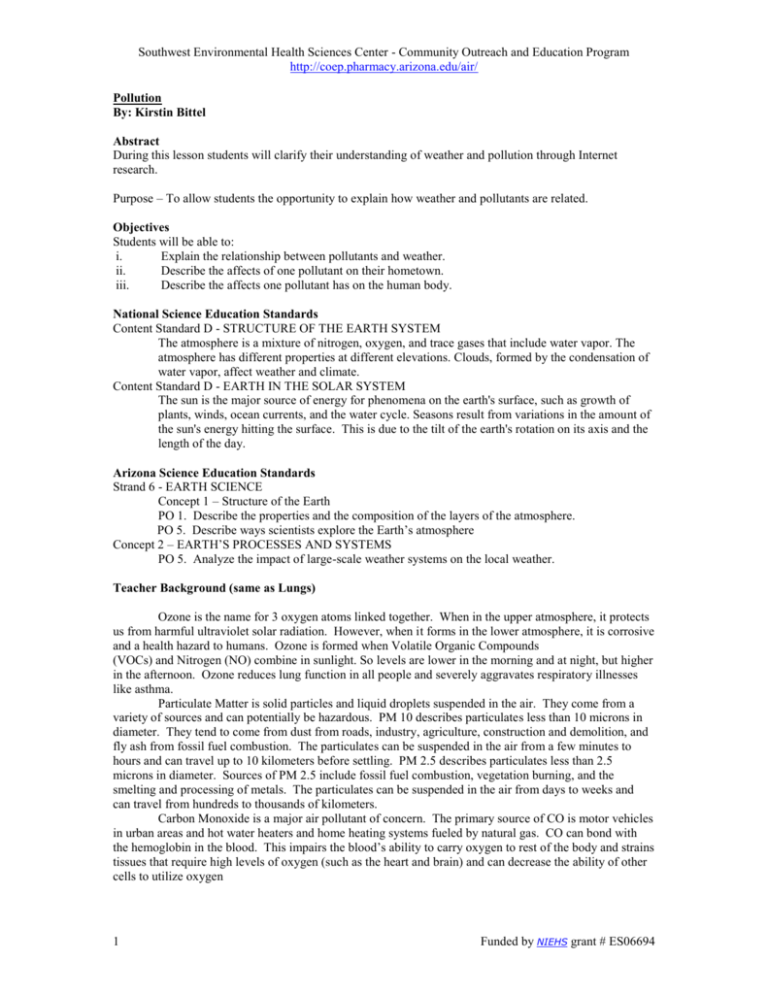
Southwest Environmental Health Sciences Center - Community Outreach and Education Program http://coep.pharmacy.arizona.edu/air/ Pollution By: Kirstin Bittel Abstract During this lesson students will clarify their understanding of weather and pollution through Internet research. Purpose – To allow students the opportunity to explain how weather and pollutants are related. Objectives Students will be able to: i. Explain the relationship between pollutants and weather. ii. Describe the affects of one pollutant on their hometown. iii. Describe the affects one pollutant has on the human body. National Science Education Standards Content Standard D - STRUCTURE OF THE EARTH SYSTEM The atmosphere is a mixture of nitrogen, oxygen, and trace gases that include water vapor. The atmosphere has different properties at different elevations. Clouds, formed by the condensation of water vapor, affect weather and climate. Content Standard D - EARTH IN THE SOLAR SYSTEM The sun is the major source of energy for phenomena on the earth's surface, such as growth of plants, winds, ocean currents, and the water cycle. Seasons result from variations in the amount of the sun's energy hitting the surface. This is due to the tilt of the earth's rotation on its axis and the length of the day. Arizona Science Education Standards Strand 6 - EARTH SCIENCE Concept 1 – Structure of the Earth PO 1. Describe the properties and the composition of the layers of the atmosphere. PO 5. Describe ways scientists explore the Earth’s atmosphere Concept 2 – EARTH’S PROCESSES AND SYSTEMS PO 5. Analyze the impact of large-scale weather systems on the local weather. Teacher Background (same as Lungs) Ozone is the name for 3 oxygen atoms linked together. When in the upper atmosphere, it protects us from harmful ultraviolet solar radiation. However, when it forms in the lower atmosphere, it is corrosive and a health hazard to humans. Ozone is formed when Volatile Organic Compounds (VOCs) and Nitrogen (NO) combine in sunlight. So levels are lower in the morning and at night, but higher in the afternoon. Ozone reduces lung function in all people and severely aggravates respiratory illnesses like asthma. Particulate Matter is solid particles and liquid droplets suspended in the air. They come from a variety of sources and can potentially be hazardous. PM 10 describes particulates less than 10 microns in diameter. They tend to come from dust from roads, industry, agriculture, construction and demolition, and fly ash from fossil fuel combustion. The particulates can be suspended in the air from a few minutes to hours and can travel up to 10 kilometers before settling. PM 2.5 describes particulates less than 2.5 microns in diameter. Sources of PM 2.5 include fossil fuel combustion, vegetation burning, and the smelting and processing of metals. The particulates can be suspended in the air from days to weeks and can travel from hundreds to thousands of kilometers. Carbon Monoxide is a major air pollutant of concern. The primary source of CO is motor vehicles in urban areas and hot water heaters and home heating systems fueled by natural gas. CO can bond with the hemoglobin in the blood. This impairs the blood’s ability to carry oxygen to rest of the body and strains tissues that require high levels of oxygen (such as the heart and brain) and can decrease the ability of other cells to utilize oxygen 1 Funded by NIEHS grant # ES06694 Southwest Environmental Health Sciences Center - Community Outreach and Education Program http://coep.pharmacy.arizona.edu/air/ Related and Resource Websites http://coep.pharmacy.arizona.edu/air/ http://www.airinfonow.org/html/health.html http://www.airinfonow.org/html/ozone.html http://www.airinfonow.org/monsites/report.asp http://www.cdc.gov/nceh/airpollution/default.htm Time Preparation Time 1-2 class period (45 minutes) 5 minutes Materials Computers Teacher Preparation Reserve lab for 1-2 days Activity 1. 2. 3. 4. 5. 6. 2 As students enter the room have the following questions on the board for them to answer on paper: “Which of the 4 pollutants we examined yesterday do you believe is the easiest to control? Why? The hardest? Why?” Allow students a few minutes to write their answers, and then have a few volunteers share their ideas.. Tell the students that their groups will each research the affects of one of the four pollutants discussed yesterday in Ozone, Particulate Matter, and Carbon Monoxide – Oh My! Divide your class into 8 groups and assign pollutants. (It is recommended that there be at least 8 groups, with 2 groups working on each pollutant. This will facilitate discussion in the following lesson Pollutant Posters.) Tell students to be sure that their research includes the following items. Of course more information is better and should reflect a higher score. What are the current city levels of your pollutant? What are the monthly/yearly averages? (Might time of year affect these averages?) What produces the pollutant? (This should be very detailed) Where are the highest levels in the city? Why? What weather systems affect the pollutant? What air currents affect the pollutant? Remind students to take notes and cite their sources. Several good cites are listed in the resources section of this lesson. Of course the list is not all-inclusive. Funded by NIEHS grant # ES06694
